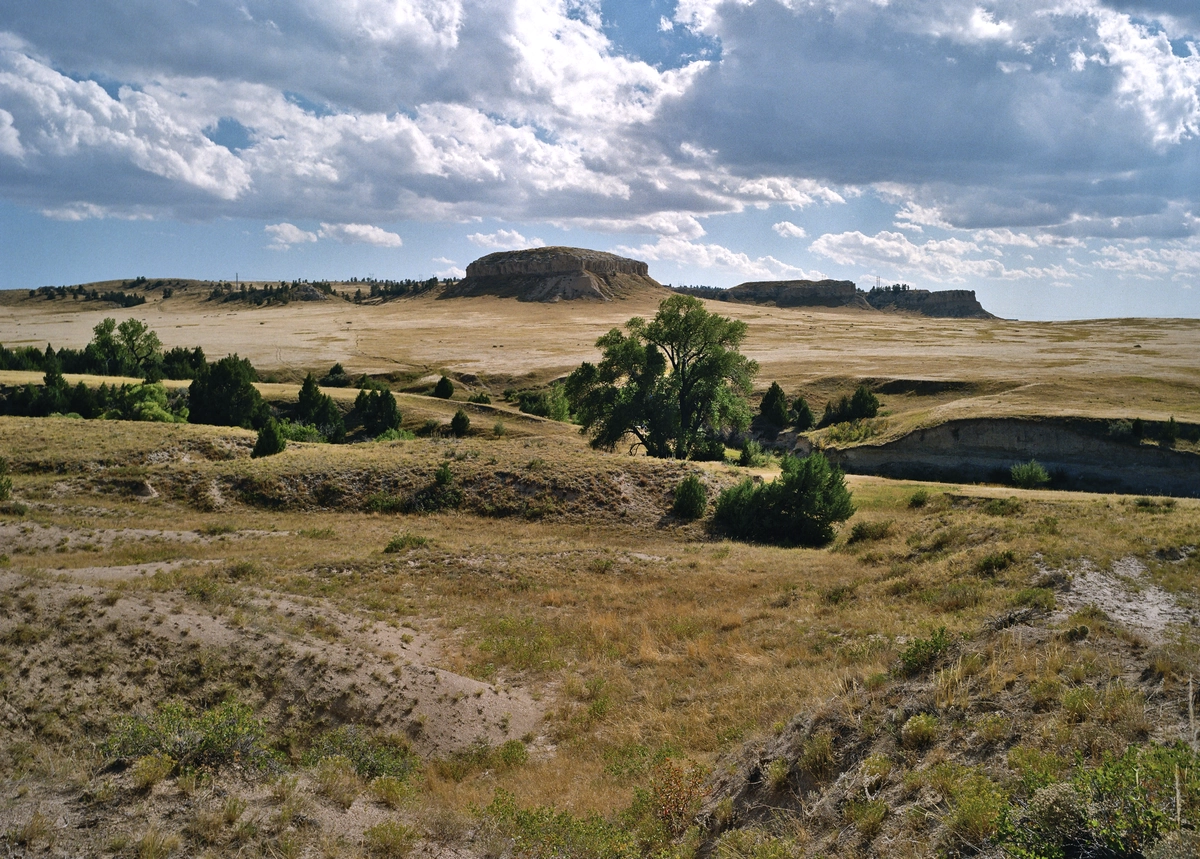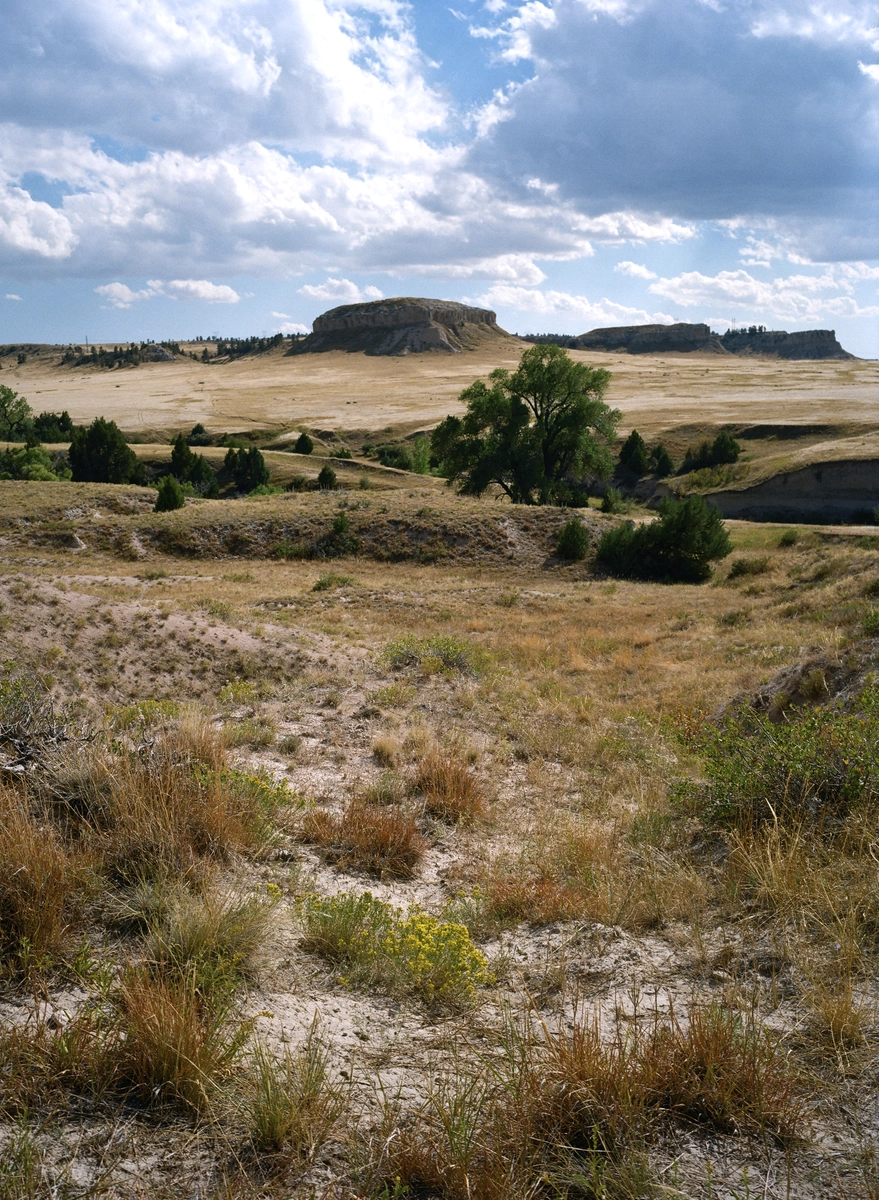It’s a silent sentinel — a low mesa rising above the western Nebraska plains, weathered by wind and time, hiding layers of human occupation. Signal Butte, perched above Robidoux Pass in western Nebraska, is more than a landmark. It’s one of the most important archaeological sites in the Central Plains. Its bones, hearths, and tool fragments whisper of people who lived here long before settlers crossed in wagon trains.
1. The Land & The Butte: Geology, Setting, and Precontact Context
Before human footsteps, the land shaped possibilities. Signal Butte rises about 120 feet above the surrounding plain, an erosional remnant capped by gravel and wind-blown soil. It stands west of Scotts Bluff County, near Robidoux Pass, within the North Platte River watershed.
Geologically, the butte and surrounding terrain reflect the region’s layered story. The base units belong to the Brule Formation and overlying fluvial and eolian deposits shape local stratigraphy. The cap of gravels and aeolian soil helps preserve artifact-bearing deposits. Because of differential erosion, mesas like this often retain cultural deposits that the surrounding plains have lost.
Western Nebraska sits at a shifting frontier between upland prairie, river valleys, and the Rocky Mountain foothills. Patterns of hunting, gathering, mobility, and exchange played out here for thousands of years. The Plains were never empty; people adapted in complex ways across the region. An elevated vantage such as Signal Butte, with routes nearby and access to water and game, would have been an obvious camp or lookout.
2. Strong Arrives: Excavation in 1931–32 and the Emergence of Signal Butte
William Duncan Strong, an ambitious archaeologist with the Smithsonian, was among the first to explore this butte systematically. In 1931–32 he organized field campaigns across Nebraska, and Signal Butte became one of his prime targets.
Strong’s reconnaissance and excavation were pioneering for Plains archaeology. His team dug stratigraphic trenches and recorded soil layers, artifact positions, and hearths with more precision than most earlier efforts. They found:
- Three cultural horizons stacked in the butte’s sediments.
- Stone projectile points, flakes, drills, and bone implements such as awls.
- Hearths, storage pits, fireplaces, and other signs of repeated use.
- Lower levels tentatively dated between about 5,000 and 1,500 years ago, spanning Middle Archaic through Late Archaic into early Woodland times.
Strong published his findings and used the site to shape early Plains cultural sequences. His work came just before the revolution of absolute dating but laid the groundwork for it.
3. Carbon Dating Comes to the Plains
Signal Butte became one of the first archaeological sites in the Plains region to be radiocarbon dated. When scientists in the late 1940s and early 1950s introduced carbon-14 dating, later researchers returned to Strong’s carefully documented horizons. Charcoal and bone from the butte were among the earliest Plains samples tested.
The results gave the site firm ages instead of typological guesses. It became a benchmark for anchoring Archaic and Woodland phases in real time. Those first assays were imperfect by today’s standards — contamination and calibration were not yet fully understood — but they marked a turning point. Signal Butte helped shift the Great Plains from relative chronologies based on artifact style into the era of scientific dating.
4. Later Excavations, Recognition, and Official Status
Strong’s early work was only the beginning. In the 1940s and 1950s other archaeologists reopened parts of the butte, refining stratigraphy, sampling for more radiocarbon tests, and expanding artifact analysis. These efforts deepened understanding of how the site formed and how people used it over thousands of years.
By the 1960s Signal Butte was officially recognized as a National Historic Landmark and added to the National Register of Historic Places, acknowledging its exceptional importance in understanding early human history on the Plains. In the professional record it continues to carry its formal Smithsonian site designation: trinomial 25SF1, identifying it as site number 1 in Scotts Bluff County, Nebraska.
5. Life on the Butte: What the Evidence Shows
Archaeologists interpret Signal Butte as a repeated seasonal camp — a place where mobile hunter-gatherer groups stopped to process game, maintain tools, and perhaps wait out weather before moving on. The hearths, storage pits, stone debris, and bone tools suggest work stations rather than permanent villages.
Because its layers span millennia, the butte lets us watch lifeways evolve: tool styles shift, hunting strategies adapt, and mobility patterns change as climate and resources fluctuate. Its absolute dates anchor the timeline of Plains prehistory and help compare far-flung sites.
6. Controversies & Critiques
Signal Butte’s fame didn’t protect it from scrutiny. Scholars have raised several concerns about Strong’s interpretations:
- Mixing of layers: Wind and animal activity could have blurred boundaries, letting artifacts drift between levels.
- Wide date ranges: Strong’s original chronologies, built before carbon dating, may have stretched the evidence to fit regional frameworks.
- Big conclusions, small sample: His excavations covered limited ground, yet he inferred sweeping cultural changes from them.
Later radiocarbon work and new analytical techniques have adjusted some of Strong’s timelines and toned down his broad claims. Still, the site remains foundational — its limits are reminders to treat early fieldwork with respect but not reverence.
7. Modern Relevance to Native Nations
For many Native Americans, Signal Butte is more than a scientific dig. It represents a tangible link to ancestors who lived and traveled the Central Plains long before settlers and surveyors arrived.
Tribal historians and cultural resource specialists view such sites as part of living heritage. Even if exact tribal affiliations for ancient occupations cannot always be named — people moved, merged, and adapted — the continuity of presence matters. For descendants of Plains nations such as the Lakota, Cheyenne, Arapaho, Pawnee, and others with historic ties to western Nebraska, these ancient camps signal that their stories reach back thousands of years.
Modern consultation practices recognize this. When federal or state agencies consider work near sites like Signal Butte, tribes are often invited to consult, provide traditional knowledge, and advise on protection. Oral histories and cultural teachings sometimes connect mesas and high points with watchfulness, signaling, or spiritual presence — fitting symbolism for a place archaeologists later named “Signal Butte.”
Some Native educators also use sites like this to teach youth about resilience and adaptation: how ancestors thrived in challenging grassland environments, moved with herds, and innovated with tools and fire long before contact. For many, the butte’s continued protection as a National Historic Landmark and National Register site means cultural survival as much as scientific data.
8. Legacy and Lessons
Signal Butte’s influence radiates beyond Nebraska. It helped usher in the shift from artifact typologies to scientific dating. It illustrates the power — and pitfalls — of early twentieth-century archaeology: daring excavation, new stratigraphic thinking, and a willingness to revise.
For modern archaeologists, it’s both reference and caution. For Native nations, it’s memory and connection. For anyone standing on the plains today, it’s a reminder that these quiet hillsides hold deep time — and that our understanding of the past is still evolving.
References and research
- Signal Butte (overview, NHL/NRHP, 25SF1)
- NPS: National Historic Landmarks by State (includes Signal Butte)
- Smithsonian NAA: William Duncan Strong papers (Signal Butte fieldwork)
- Frontier Stories: Reading & Writing Plains Archaeology (Kirby/Strong 1932 record)
- Nebraska Archaeology: “Behind the 2016 Poster – Signal Butte”
- Nebraska Public Media: Signal Butte — Hidden in Plain Sight (video)
- History Nebraska: The Ndee in Nebraska (context; Ash Hollow & Signal Butte)
- NPS/Scotts Bluff: Geology brochure (Brule, Whitney ash, Gering)
- NPS/Scotts Bluff: Geology & Paleontology page
- NPS Geologic Resources Inventory Report — Scotts Bluff NM
- UNL Museum Bulletin: Brule–Gering Contact in the Wildcat Ridge
- Schultz (1967): Brule–Gering Contact (Wildcat Ridge area) PDF
- Minnesota’s Archaic Tradition (Signal Butte 25SF1 summary)
- History Nebraska: Archeology in the Ash Hollow Locality
- Ash Hollow State Historical Park (NHL cave background)
- Hudson–Meng Bison Bonebed (context; shifting interpretations)
- UNL: Preliminary Analysis of the Bison Bones from Hudson–Meng (1973)







